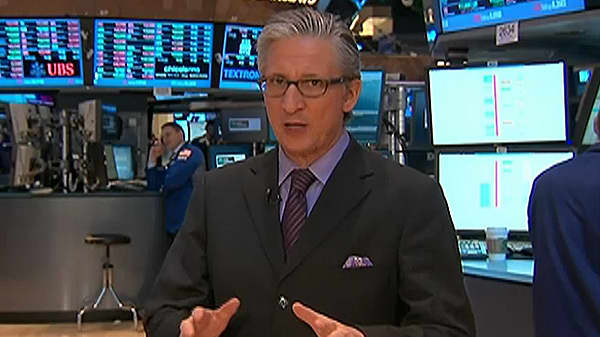Stocks have gotten a boost from better economic reports such as Friday's stronger-than-expected ISM manufacturing data and Tuesday's 16-percent jump in new home sales to July 2008 levels. But stocks first sold off sharply Monday amid concerns that Italy's election outcome left no clear winner, and the strength of anti-euro candidates could mean trouble for the euro zone.
(Read More: Home Buyers Are Back, but Where Are the Houses?)
Fed Chairman Ben Bernanke gave encouragement to the market this past week after he stood by the Fed's quantitative easing program in two days of Congressional testimony, convincing traders the Fed will not stop easing anytime soon.
"We're trading on this bed of liquidity and the fundamentals are getting better. We think the job prospects are, too," said Stuart Freeman, chief U.S. equity strategist at Wells Fargo Advisors. "We're going to get pullbacks from time to time but I think the pullbacks we get for now are more likely to moderate and not last that long."
The Dow finished Friday a half percent away from its October 2007 closing high of 14,164. After a volatile week, the Dow ended up at 14,089, a gain of 0.6 percent for the week.
"We're close to it. The market fluctuates, and I think it's going to rise and we'll probably see it soon," said Ed Keon, portfolio manager with Quantitative Management Associates.
Keon expects the market to continue scoring gains and he says it's reasonably priced. "Things look less bad than they did a year ago. I'm sure we'll hit plenty of bumps on the road, but I think it's important to keep the big picture in mind — things are getting better," he said.
Keon said the sequester, or automatic spending cuts, that went into effect Friday didn't rattle the market because they are not that huge and the market has written off Washington's "dysfunction."
"The market doesn't really care…It's hard for Washington to surprise the market on the downside," he said. But analysts do believe the market could start to worry as March 27 approaches, when Congress needs to pass a resolution to fund the budget.
Freeman also expects the Dow to head into record territory soon and the S&P 500 could follow along as well. But he said big milestones sometimes trigger selloffs so it could be choppy after the Dow breaks through record territory. The Dow came within 15 points of the high Thursday.
(Read More: Will Transports Drive the Dow Higher This Year?)
"We're at a point which you like to see," said Freeman. "When you get into this next phase or middle phase of a bull market, bad news or perceived bad news or bad stories come out and the market seems not to care. We're seeing more and more of that, ever since we got through the fiscal cliff, through the election. We had a whole basket of things, less worry about Europe. We kind of went through a funk for the last 12 months…Some of the funk has lifted a little bit."
The S&P 500 was up 0.2 percent for the week, at 1518, but it is still three percent away from its all-time high. The Nasdaq was up 0.3 percent, at 3169. Treasurys saw buying this week as investors sought safety, and the 10-year was yielding 1.85 percent late Friday, well below its recent range near 2 percent.
Currency Wars Redux
The dollar could get a boost in the week ahead, FX Analystics strategist David Gilmore said, after the euro temporarily dipped below 1.30 on Friday — the first time that's happened since December. The currency market will keep its focus on Italy's efforts to create a government, and a number of meetings of central bankers and finance ministers.
Euro-zone finance ministers meet on Monday and Ecofin, the broader group of European Union finance ministers meet Tuesday. Analysts expect to see discussion of Italy at the meetings.
"They'll try to bring down the market's anxiety," said Brown Brothers Harriman chief currency strategist Marc Chandler. He said it could take a while for Italy to form a government, keeping markets on edge. "Even in the best of conditions, it's a protracted process," he said.
"They've got other fish on their plates. They'll be getting reports on how Portugal is doing, Greece an Cyprus…They could make noises that the euro group is willing to extend their budget targets for another year. It could help Spain and France," Chandler said.
After the European finance ministers meetings on Monday and Tuesday, "then it's sort of Central Bank-palooza with ECB, BOE, BOC RBA and BOJ," said Gilmore.
(Read More: Europe Wants to See Gain Before More Austerity Pain, Blair Says)
The European Central Bank could signal there's scope to cut rates when it meets Thursday because of the weakening economic picture for countries other than Germany, Gilmore said.
Analysts expect the Bank of England to announce that it's expanding its quantitative easing program when it meets Thursday.
The Bank of Japan meets Wednesday and Thursday and it is the final meeting run by outgoing BOJ Gov. Masaaki Shirakawa, so no actions are expected.
The Bank of Canada meets Wednesday, and it may drop its tightening bias. "They've held it for over a year," Gilmore said "The data is just piling up. things are unraveling…Markets are sort of pricing in an easier policy out of Bank of Canada."
Then there are several Fed speakers in the week ahead, including Fed Gov. Janet Yellen who speaks at a National Association of Business Economists meeting in Washington Monday.





